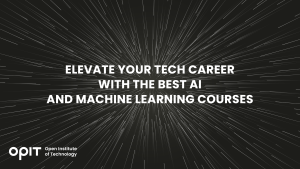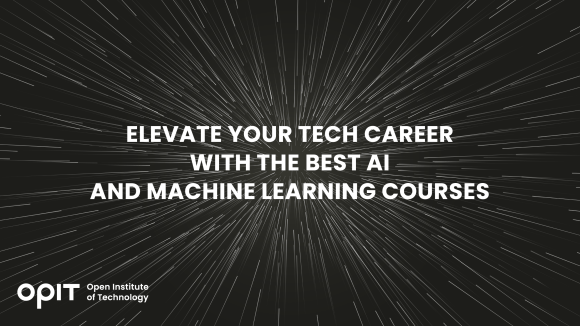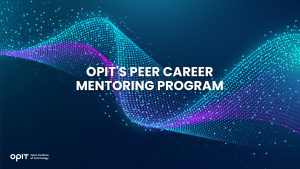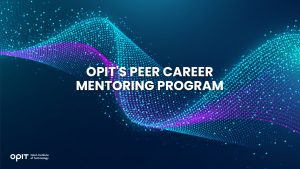

Artificial Intelligence (AI) and machine learning are two of the fastest-growing emerging technologies right now. In late 2022, generative AI burst onto the tech scene in the shape of ChatGPT and its antecedents. However, that’s not the first time AI has made a major impact. In fact, the first AI chatbot, Eliza, was around in the 1960s.
Both AI and machine learning do far more than chat and research. AI is embedded in analytics, predictive forecasting, and monitoring for multiple industries. As the use of AI and machine learning expands, the need for professionals with relevant skills is also growing exponentially.
OPIT (Open Institute of Technology) provides top-tier education in various tech fields, including highly respected machine learning and artificial intelligence courses. Let’s take a look at these fascinating technologies and how the right AI machine learning course can elevate your tech career.
Understanding AI and Machine Learning
When you’re searching for courses on artificial intelligence and machine learning, it helps to have a basic definition for both terms. If you already work in the tech industry, you likely work with one or both of these technologies every day. Yet they’re often so embedded within systems or apps that you might not even realize.
AI refers to the computer’s to exhibit behavior that replicates human thought patterns. However, the details of this definition are a little more complex than that. “Computers” can mean anything from a small subsystem to a supercomputer. It can also mean your smartphone or an app. And, by emulating human behavior, experts don’t necessarily mean AI does things exactly like us. Truly “thinking” AI with genuine cognitive abilities is a long way off.
What AI actually does is take things humans can already do – and do it faster and more often. Think about a software DevOps team requiring automated monitoring and testing of code prior to deployment. AI can do this while checking for vulnerabilities and producing relevant, actionable reports. In healthcare, AI uses pattern recognition to diagnose diseases quickly.
Machine learning is a subset of AI. It focuses on using algorithms to consistently and continuously improve pattern recognition for AI that appears to “learn.”
Courses in AI and machine learning are so popular because of the inherent usefulness of these technologies. Learning these skills now is a way to future-proof your tech career.
The Best AI and Machine Learning Courses
Numerous artificial intelligence and machine learning courses cover different topics and niches. You may choose to learn in a classroom setting or remotely. Some courses are short-term, generally covering foundational aspects of AI. Others carry on over several months for a deeper learning experience. Always consider how the course you invest in will impact your career advancement opportunities.
Absolute beginners may benefit from the Coursera IBM Applied Professional Certificate. This course runs entirely online over three months, presuming you can commit to 10 hours a week. Students learn the basics of AI, particularly how it powers IBM’s Watson AI services.
Oxford Online runs a 6-week online AI program course requiring 7-10 hours of commitment a week. This course looks at AI concepts and business cases for implementation and takes a glimpse at the future of AI.
For classroom-based courses on AI and machine learning, prospective students are best placed to contact local educational institutions. Offline courses vary in length, depth, and usefulness, so always check the syllabus and what certification you gain. It’s worth considering how far you’ll have to travel to gain a qualification.
One of the biggest challenges with AI is making it ethical. OPIT addresses that head-on with the MSc in Responsible AI. Learn advanced AI skills while keeping inclusivity and human interest at the heart of every aspect of the syllabus.
OPIT also offers other courses that consider the impact AI has on modern business practice. Undergraduates could consider the BSc in Digital Business, which includes a full Introduction to AI segment. There are also elective topics, including AI-Driven Software Development.
The Structure of AI and Machine Learning Courses
What should you expect from the best courses on AI and machine learning? Each course has a specific length, either in terms of study hours or a set deadline date. Most online courses have a specific intake date to make sure students get the right support at the right time.
Once you start your machine learning and AI course, you can expect a good balance between theory and practical application. For example, OPIT’s master’s degree course starts with foundational theory and critical thinking around ethics in AI. From here, students get to handle complex data sets. They program in Python and learn how to design effective AI-powered data pipelines.
The structure of your course will depend on the focus, but to give you the best foundation, courses may follow a similar pathway to this:
- Basics of AI, including the differences between AI and machine learning
- Discovering applications of AI — these may be general or industry-specific, depending on the nature of your course
- Data collation, analysis, and visualization
- Programming for AI
- Natural language processing (NLP) and natural language generation (NLG)
- Removing or preventing bias in AI training
Some courses will also offer advanced elective programs, such as understanding AI within the sphere of FinOps (financial operations) or business strategy. If you have a particular industry you’re hoping to excel in, look out for courses with topics that could help you further those ambitions.
Online AI and Machine Learning Courses: Flexibility and Accessibility
Choosing one of the best machine learning and AI courses to do online offers more benefits than new skills. Online learning allows you to study in your preferred environment and at your own pace. You just need to make sure you keep an eye on set deadlines.
You’re not distracted by a class full of people, but you still have access to tutors and support. Many open learning institutes have online communities of students. These are great for preventing isolation and gaining advice.
As a tech professional, the ability to set your own study schedule is essential. Online AI and machine learning courses provide flexibility, allowing you to learn as you work. With OPIT’s Master’s Degree in Responsible Artificial Intelligence, you could potentially have an MSc in 12-18 months without taking any time off work.
Key Skills Gained from AI and Machine Learning Courses
When choosing your online course on AI and machine learning, consider the skills you’ll learn. You should expect to cover:
- Data preprocessing
- Data cleansing
- Data visualization and storytelling
- Linear and nonlinear dimensionality reduction
- Manifold learning
- Human-centered AI design
- Language-agnostic AI programming skills
An MSc in AI and machine learning provides specialized skills and knowledge that you can use to address complex AI challenges in just about any industry.
Choosing the Right AI and Machine Learning Course for You
Picking the right AI and machine learning course is simpler when you consider your goals. Do you want a quick upskill and insight into emerging technologies? Or do you want an immersive course that empowers you to take on new career challenges? Most AI and machine learning courses will provide guidance on the type of career students could hope to pursue after completion.
Always look at the syllabus of a course and see if it meets your personal goals. If you’re unsure about any aspects, contact the education provider for more information.
OPIT’S MSc in Responsible Artificial Intelligence: An Overview
If you’ve decided an online AI and machine learning course is for you, as a graduate, an MSc is the natural choice. The next intake for the OPIT MSc in Responsible AI is September 2024, and details on how to apply are online.
What are the benefits of taking this course?
- A fast-track option to gain your master’s degree in just 12 months
- Fully inclusive fees — no hidden charges
- Various scholarship and funding options
- Availability of early-bird discounts
- Access to academic leaders from all over the world
- Education with an EU-accredited institution
Your MSc course covers every aspect of AI you might require for a career in AI and machine learning. Topics start with AI and ethics and quickly move into human-centered design, computer vision, and how AI impacts IoT and automation.
As you move into your final term, you start your MSc thesis, which focuses on AI projects with industrial relevance. There’s also the opportunity to pursue an internship to complement your thesis and gain vital experience.
AI and Machine Learning Courses for a Future-Proof Career
AI is now part of most growing industries, from property and real estate to healthcare and social care. Tech professionals have the opportunity to upskill themselves and move into fields that they have a real passion for. Organizations are looking for and willing to pay high salaries for knowledgeable, qualified AI experts.
Taking the time now to embark on machine learning and AI courses could speed your journey along your chosen career trajectory.
Related posts

Source:
- Raconteur, published on November 06th, 2025
Many firms have conducted successful Artificial Intelligence (AI) pilot projects, but scaling them across departments and workflows remains a challenge. Inference costs, data silos, talent gaps and poor alignment with business strategy are just some of the issues that leave organisations trapped in pilot purgatory. This inability to scale successful experiments means AI’s potential for improving enterprise efficiency, decision-making and innovation isn’t fully realised. So what’s the solution?
Although it’s not a magic bullet, an AI operating model is really the foundation for scaling pilot projects up to enterprise-wide deployments. Essentially it’s a structured framework that defines how the organisation develops, deploys and governs AI. By bringing together infrastructure, data, people, and governance in a flexible and secure way, it ensures that AI delivers value at scale while remaining ethical and compliant.
“A successful AI proof-of-concept is like building a single race car that can go fast,” says Professor Yu Xiong, chair of business analytics at the UK-based Surrey Business School. “An efficient AI technology operations model, however, is the entire system – the processes, tools, and team structures – for continuously manufacturing, maintaining, and safely operating an entire fleet of cars.”
But while the importance of this framework is clear, how should enterprises establish and embed it?
“It begins with a clear strategy that defines objectives, desired outcomes, and measurable success criteria, such as model performance, bias detection, and regulatory compliance metrics,” says Professor Azadeh Haratiannezhadi, co-founder of generative AI company Taktify and professor of generative AI in cybersecurity at OPIT – the Open Institute of Technology.
Platforms, tools and MLOps pipelines that enable models to be deployed, monitored and scaled in a safe and efficient way are also essential in practical terms.
“Tools and infrastructure must also be selected with transparency, cost, and governance in mind,” says Efrain Ruh, continental chief technology officer for Europe at Digitate. “Crucially, organisations need to continuously monitor the evolving AI landscape and adapt their models to new capabilities and market offerings.”
An open approach
The most effective AI operating models are also founded on openness, interoperability and modularity. Open source platforms and tools provide greater control over data, deployment environments and costs, for example. These characteristics can help enterprises to avoid vendor lock-in, successfully align AI to business culture and values, and embed it safely into cross-department workflows.
“Modularity and platformisation…avoids building isolated ‘silos’ for each project,” explains professor Xiong. “Instead, it provides a shared, reusable ‘AI platform’ that integrates toolchains for data preparation, model training, deployment, monitoring, and retraining. This drastically improves efficiency and reduces the cost of redundant work.”
A strong data strategy is equally vital for ensuring high-quality performance and reducing bias. Ideally, the AI operating model should be cloud and LLM agnostic too.
“This allows organisations to coordinate and orchestrate AI agents from various sources, whether that’s internal or 3rd party,” says Babak Hodjat, global chief technology officer of AI at Cognizant. “The interoperability also means businesses can adopt an agile iterative process for AI projects that is guided by measuring efficiency, productivity, and quality gains, while guaranteeing trust and safety are built into all elements of design and implementation.”
A robust AI operating model should feature clear objectives for compliance, security and data privacy, as well as accountability structures. Richard Corbridge, chief information officer of Segro, advises organisations to: “Start small with well-scoped pilots that solve real pain points, then bake in repeatable patterns, data contracts, test harnesses, explainability checks and rollback plans, so learning can be scaled without multiplying risk. If you don’t codify how models are approved, deployed, monitored and retired, you won’t get past pilot purgatory.”
Of course, technology alone can’t drive successful AI adoption at scale: the right skills and culture are also essential for embedding AI across the enterprise.
“Multidisciplinary teams that combine technical expertise in AI, security, and governance with deep business knowledge create a foundation for sustainable adoption,” says Professor Haratiannezhadi. “Ongoing training ensures staff acquire advanced AI skills while understanding associated risks and responsibilities.”
Ultimately, an AI operating model is the playbook that enables an enterprise to use AI responsibly and effectively at scale. By drawing together governance, technological infrastructure, cultural change and open collaboration, it supports the shift from isolated experiments to the kind of sustainable AI capability that can drive competitive advantage.
In other words, it’s the foundation for turning ambition into reality, and finally escaping pilot purgatory for good.

The Open Institute of Technology (OPIT) is the perfect place for those looking to master the core skills and gain the fundamental knowledge they need to enter the exciting and dynamic environment of the tech industry. While OPIT’s various degrees and courses unlock the doors to numerous careers, students may not know exactly which line of work they wish to enter, or how, exactly, to take the next steps.
That’s why, as well as providing exceptional online education in fields like Responsible AI, Computer Science, and Digital Business, OPIT also offers an array of career-related services, like the Peer Career Mentoring Program. Designed to provide the expert advice and support students need, this program helps students and alumni gain inspiration and insight to map out their future careers.
Introducing the OPIT Peer Career Mentoring Program
As the name implies, OPIT’s Peer Career Mentoring Program is about connecting students and alumni with experienced peers to provide insights, guidance, and mentorship and support their next steps on both a personal and professional level.
It provides a highly supportive and empowering space in which current and former learners can receive career-related advice and guidance, harnessing the rich and varied experiences of the OPIT community to accelerate growth and development.
Meet the Mentors
Plenty of experienced, expert mentors have already signed up to play their part in the Peer Career Mentoring Program at OPIT. They include managers, analysts, researchers, and more, all ready and eager to share the benefits of their experience and their unique perspectives on the tech industry, careers in tech, and the educational experience at OPIT.
Examples include:
- Marco Lorenzi: Having graduated from the MSc in Applied Data Science and AI program at OPIT, Marco has since progressed to a role as a Prompt Engineer at RWS Group and is passionate about supporting younger learners as they take their first steps into the workforce or seek career evolution.
- Antonio Amendolagine: Antonio graduated from the OPIT MSc in Applied Data Science and AI and currently works as a Product Marketing and CRM Manager with MER MEC SpA, focusing on international B2B businesses. Like other mentors in the program, he enjoys helping students feel more confident about achieving their future aims.
- Asya Mantovani: Asya took the MSc in Responsible AI program at OPIT before taking the next steps in her career as a Software Engineer with Accenture, one of the largest IT companies in the world, and a trusted partner of the institute. With a firm belief in knowledge-sharing and mutual support, she’s eager to help students progress and succeed.
The Value of the Peer Mentoring Program
The OPIT Peer Career Mentoring Program is an invaluable source of support, inspiration, motivation, and guidance for the many students and graduates of OPIT who feel the need for a helping hand or guiding light to help them find the way or make the right decisions moving forward. It’s a program built around the sharing of wisdom, skills, and insights, designed to empower all who take part.
Every student is different. Some have very clear, fixed, and firm objectives in mind for their futures. Others may have a slightly more vague outline of where they want to go and what they want to do. Others live more in the moment, focusing purely on the here and now, but not thinking too far ahead. All of these different types of people may need guidance and support from time to time, and peer mentoring provides that.
This program is also just one of many ways in which OPIT bridges the gaps between learners around the world, creating a whole community of students and educators, linked together by their shared passions for technology and development. So, even though you may study remotely at OPIT, you never need to feel alone or isolated from your peers.
Additional Career Services Offered by OPIT
The Peer Career Mentoring Program is just one part of the larger array of career services that students enjoy at the Open Institute of Technology.
- Career Coaching and Support: Students can schedule one-to-one sessions with the institute’s experts to receive insightful feedback, flexibly customized to their exact needs and situation. They can request resume audits, hone their interview skills, and develop action plans for the future, all with the help of experienced, expert coaches.
- Resource Hub: Maybe you need help differentiating between various career paths, or seeing where your degree might take you. Or you need a bit of assistance in handling the challenges of the job-hunting process. Either way, the OPIT Resource Hub contains the in-depth guides you need to get ahead and gain practical skills to confidently move forward.
- Career Events: Regularly, OPIT hosts online career event sessions with industry experts and leaders as guest speakers about the topics that most interest today’s tech students and graduates. You can join workshops to sharpen your skills and become a better prospect in the job market, or just listen to the lessons and insights of the pros.
- Internship Opportunities: There are few better ways to begin your professional journey than an internship at a top-tier company. OPIT unlocks the doors to numerous internship roles with trusted institute partners, as well as additional professional and project opportunities where you can get hands-on work experience at a high level.
In addition to the above, OPIT also teams up with an array of leading organizations around the world, including some of the biggest names, including AWS, Accenture, and Hype. Through this network of trust, OPIT facilitates students’ steps into the world of work.
Start Your Study Journey Today
As well as the Peer Career Mentoring Program, OPIT provides numerous other exciting advantages for those who enroll, including progressive assessments, round-the-clock support, affordable rates, and a team of international professors from top universities with real-world experience in technology. In short, it’s the perfect place to push forward and get the knowledge you need to succeed.
So, if you’re eager to become a tech leader of tomorrow, learn more about OPIT today.
Have questions?
Visit our FAQ page or get in touch with us!
Write us at +39 335 576 0263
Get in touch at hello@opit.com
Talk to one of our Study Advisors
We are international
We can speak in:


